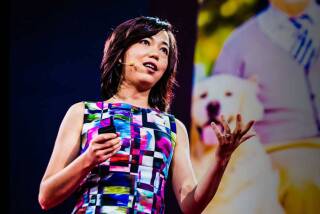Bugs Started Science Prodigy on Path to Major Prize
- Share via
Bugs provided the first clue that the child of Shiang and Nai-Li Liu was headed for science stardom. As a young boy, David Ruchien Liu would stand for hours in the back yard of the family’s Riverside home, watching insects.
“He was just fascinated by the bugs,” his mother, physicist Nai-Li Liu, recalled.
By age 7, the youth had abandoned entomology for an Apple computer. And by 13, he had won top honors at a state science fair for a project proving that mice can recognize sequential patterns.
On Monday, Liu reached a dizzying new pinnacle. Edging out 38 other finalists from around the country, the 16-year-old senior at Riverside’s Polytechnic High School earned second place in the Westinghouse Science Talent Search, considered by many the naton’s most prestigious youth science competition.
Liu was one of two Southern California students who excelled in the contest. Royce Yung-Tze Peng, a 17-year-old senior at Rolling Hills High School in Rolling Hills Estates, won sixth place.
Those who know the boys are not surprised by their success.
Marjorie Herring, who coaches Liu on Polytechnic’s academic decathlon team, said of him, “He is a remarkable boy. I think we all agree that sometime down the road, we’re going to hear much about this young man.”
Peng’s best friend, Herrick Wun, said, “He is known as the brain on campus. He’s known by pretty much everyone, and everyone asks him for help in math and science. Everyone figures he must know it, so they never doubt him.”
Liu’s award-winning entry involved the use of a computer to simulate the human visual process. He used the model--which employed neural networks--in tests aimed at understanding how neural densities in the brain affect visual processing, and then conducted experiments on 40 students to verify his predictions.
Liu’s father--an engineer at Aerospace Corp. in El Segundo--said his son hopes the work might be useful to researchers studying dyslexia, a disorder that leaves some victims unable to read and write despite an ability to recognize letters.
Liu works at his computer as late as 2 a.m. some nights, his parents say. But while science is his first love, Herring said Liu’s greatest strength may be his breadth of interests and talent.
He is managing editor of the campus newspaper, the Poly Spotlight, and a member of the school’s mock trial team. He plays badminton, juggles and performs card tricks. And he is an accomplished violinist and oil painter.
Peng also has excelled in non-scientific areas. He has won awards for his violin playing and serves as concertmaster for two youth orchestras.
The idea for Peng’s Westinghouse project was suggested by John Maddocks, a math professor the boys knows. Maddocks called the problem a “very natural mathematical question.”
“The problem I suggested is take two sheets of paper (and) cut a curve on either edge,” Maddocks said. “Can you join the edges without ripping or bending the paper?”
Assisted by a computer program he devised, Peng determined that it could be done, according to Westinghouse officials. The work could have potential uses in areas ranging from tailoring and sail making to aerospace or automotive manufacturing, where sheets of metal have to assume complex, three-dimensional shapes, yet meet in precise lines to join other parts of the structure.






